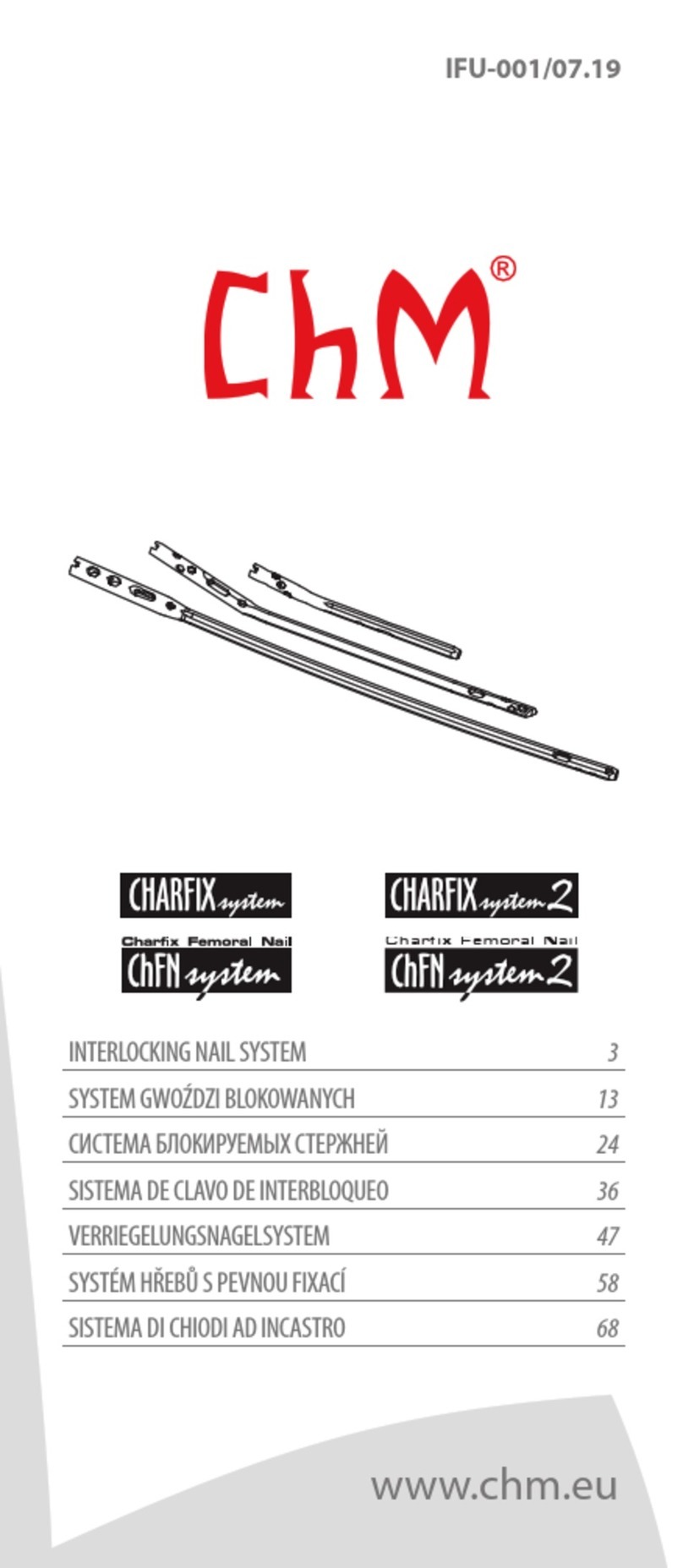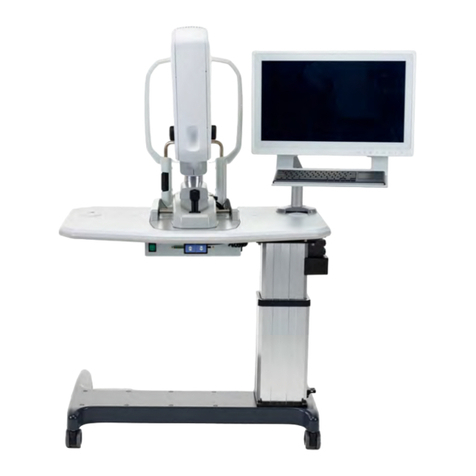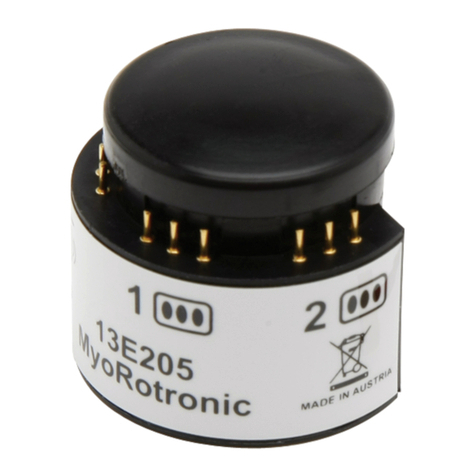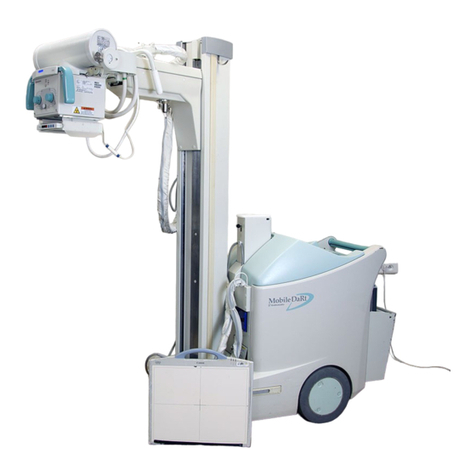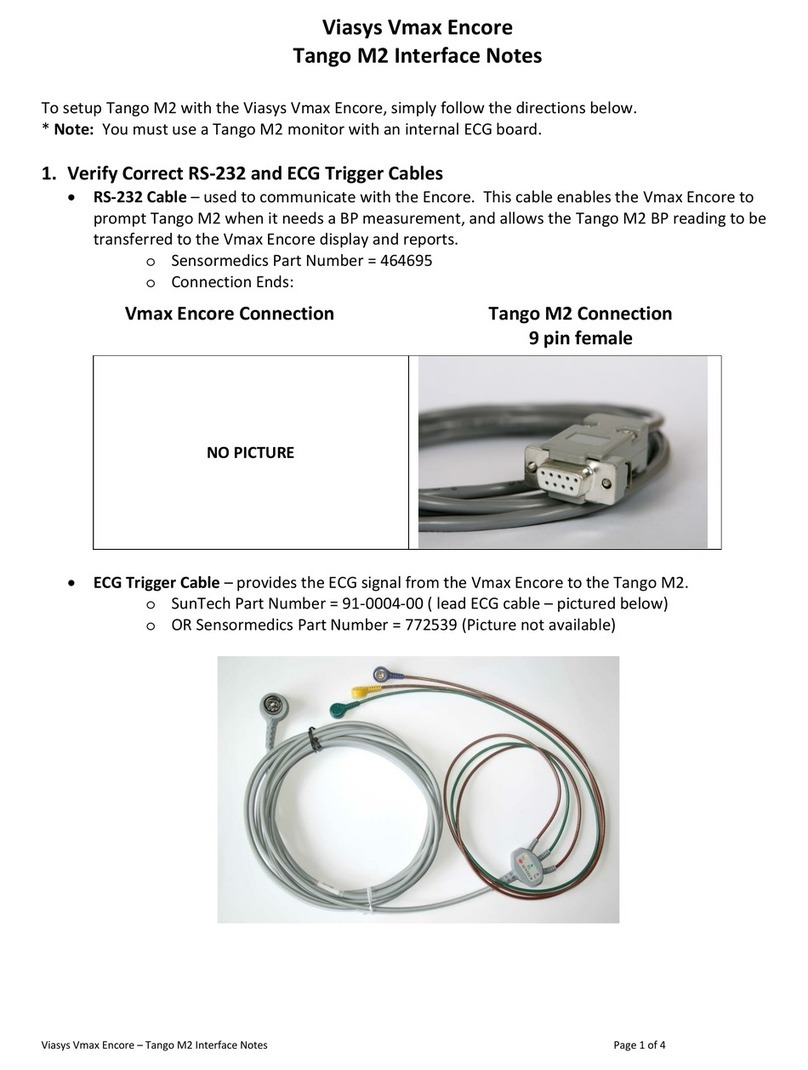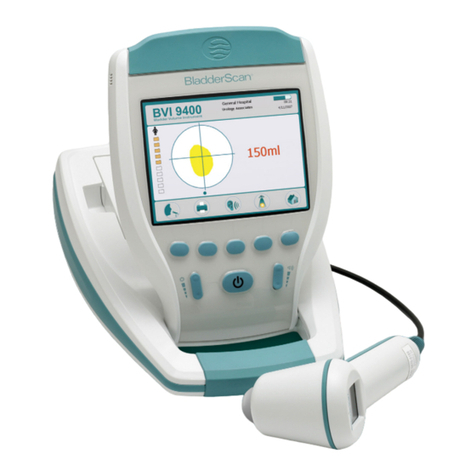ChM 3.4099 User manual

www.chm.eu
4.0ChLP distal ulnar plates
3.4099
• SURGICAL TECHNIQUE
• IMPLANTS
• INSTRUMENT SET
ST/80-402

www.chm.eu
Document No ST/80-402
Date of issue 21.07.2017
Review date P-000-05.06.2019
The manufacturer reserves the right to introduce design changes.
SYMBOLS DESCRIPTIONS
Ti Titanium or titanium alloy
Cobalt
LLeft
RRight
L R Available versions:left/right
Len Length
Torx drive
Torx drive cannulated
Hexagonal drive
Hexagonal drive cannulated
Cannulated
Locking
Diameter [mm]
HH length [mm]
Angle
88
-
340 available lengths
4-22 Available number of holes
1.8 Thickness [mm]
1:1 Scale 1:1
Number of threaded holes in the shaft part of the plate
Number of locking holes in the plate
VA Variable angle
Cortical
Cancellous
Non
Ster
Ster Available in sterile/ non- sterile condition
Refer to surgery technique
Caution - pay attention to the particular proceeding.
Perform the activity with XRay control.
Information about the next stages of the proceeding.
Proceed to the next stage.
Return to the specified stage and repeat the activity.
Before using the product, carefully read the Instructions for Use supplied with the product. It contains, among others, indications, contraindications, side effects,
recommendations and warnings related to the use of the product.
The above description is not a detailed instruction of conduct. The surgeon decides about choosing the operating procedure.
TABLE OF CONTENTS

3/22
TABLE OF CONTENTS
1. INTRODUCTION 5
2. IMPLANT DESCRIPTION 6
3. SURGICAL TECHNIQUE 8
3.1. PATIENT’S POSITIONING 8
3.2. SURGICAL APPROACH 8
3.3. FRACTURE REDUCTION 8
3.4. IMPLANT SELECTION 8
3.5. PLATE INSERTION 8
3.6. TEMPORARY PLATE STABILIZATION 9
3.7. INSERTION OF LOCKING SCREW IN THE EPIPHYSIAL PART OF THE PLATE 9
3.8. CORTICAL SCREW INSERTION 9
3.9. INSERTION OF LOCKING SCREWS IN THE SHAFT PART OF THE PLATE 10
3.10. WOUND CLOSURE 10
4. SURGICAL PROCEDURES 11
4a. PROCEDURE OF TEMPORARY IMPLANT STABILIZATION 11
4b. PROCEDURE OF CORTICAL SELF-TAPPING SCREW 2.7 [3.1220] INSERTION 12
4c. PROCEDURE OF 4.0ChLP SCREW 2.4 [3.5164] INSERTION 13
4d. PROCEDURE OF 4.0ChLP SCREW VA 2.4 [4.5235] INSERTION 14
5. POSTOPERATIVE PROCEDURE 15
6. IMPLANT REMOVAL 15
7. CATALOGUE PAGES 16
7a. INSTRUMENT SET 16
7b. IMPLANTS 17
7c. SCREWS 18
8. INSTRUCTIONS FOR USE 19


5/22
1. INTRODUCTION
Prior to use, carefully read the instructions for use supplied with the device and attached at the end of this document. It includes, e.g.: indications,
contraindications, adverse effects, recommendations and warnings related to the device use.
This surgical technique applies to 4.0ChLP locked plating system used for distal ulna bone osteosynthesis. The plates are a part of the ChLP locked plating system
developed by ChM. The presented range of implants is made of materials in accordance with ISO 5832 standards. Compliance with the requirements of quality
management systems and the requirements of Directive 93/42/EEC concerning medical devices guarantee high quality of the offered implants.
The system for the distal ulna bone treatment includes:
• implants (plates and screws),
• instrument set used for conducting a surgical procedure,
• surgical technique.
Indications
The plates are used to:
• treat articular/extra-articular fractures of distal ulna,
• perform osteotomy.
Contraindications
• infections,
• children in the growth phase.
Plate selection and shaping
The plates are available in various lengths and number of locking holes. This allows for optimal selection of the implant to the fracture type.
Shaping of the plates in their epiphysial part is not allowed.

6/22
2. IMPLANT DESCRIPTION
Distal ulnar plates are a part of 4.0ChLP system. This system includes also compatible locking screws. To facilitate their identification, both titanium plate and screws
are green anodized.
Bottom undercuts of the shaft part:
• limited bone-to-plate contact,
• better blood circulation of periimplant tissues.
Anatomical profile of the plate:
• the shape of the plate fits distal ulna.
Hole for Kirschner wire:
• easier plate positioning,
• temporary plate stabilization.
Locking holes:
• locking holes for 4.0ChLP screws.
Hook at the end of plate:
• stabilization of the distal ulna
(styloid process).
Oval-shaped compression hole:
• convenient plate positioning,
• compression possibility.

7/22
4.0ChLP distal ulnar plate

8/22
3. SURGICAL TECHNIQUE
3.1. PATIENT’S POSITIONING
It is recommended to position the patient supine, with the hand in the pronation
resting on the operating table.
3.3. FRACTURE REDUCTION
Reduce the fracture. If need be, temporarily stabilize the bone fragments with
Kirschner wire.
3.4. IMPLANT SELECTION
Choose the right size of the implant for the type of fracture, size and structure
of the bone.
3.5. PLATE INSERTION
Position the implant correctly on the bone and hook it on the styloid process
of the ulna..
3.2. SURGICAL APPROACH
A posteromedial approach is recommended. Make a longitudinal skin incision
between 4-6 cm in length.
Make sure the dorsal sensory branch of the ulnar nerve is not
damaged.

9/22
3.6. TEMPORARY PLATE STABILIZATION
The position of the implant may be stabilized by inserting Kirschner wire into
appropriate hole or using setting-compressing screw (acc. to procedure 4a).
NOTE: Confirm the correct position of the implant by taking
XRay image.
3.7. INSERTION OF LOCKING SCREW
IN THE EPIPHYSIAL PART OF THE PLATE
Insert a locking screw of a proper length in the locking hole of the epiphysial
part of the plate.
• Insert 4.0ChLP screw 2.4 [3.5164] acc. to 4c procedure,
• Insert 4.0ChLP screw VA 2.4 [4.5235] acc. to 4d procedure.
3.8. CORTICAL SCREW INSERTION
Insert cortical self-tapping screw 2.7 [3.1220] into the oval-shaped hole of the plate
(acc. to procedure 4b).
Remove Kirschner wire.

10/22
3.9. INSERTION OF LOCKING SCREWS IN THE SHAFT
PART OF THE PLATE
Insert 4.0ChLP screw 2.4 [3.5164] of a proper length in the locking hole of the shaft
part of the plate.
3.10. WOUND CLOSURE
Before closing the wound, take an XRay image in at least two projections
to confirm implant position and fracture reduction. Make sure all the screws are
properly tightened and do not penetrate the joint surface.
Use appropriate surgical technique to close the wound.

11/22
4. SURGICAL PROCEDURES
4a. PROCEDURE OF TEMPORARY IMPLANT STABILIZATION
40.4814.000
40.4896.018
40.4814.000
40.4896.018
40.5678.000
Stabilization using setting-compressing screw
• Insert threaded guide M3.5/1.8-4.0 [40.4896.018] into the locking hole
of the plate.
• Insert setting-compressing screw 1.8/120 [40.5678.000] through
the threaded guide [40.4896.018].
• Tighten the nut of the setting-compressing screw [40.5678.000] and push
the plate to the bone.
Stabilization in locking holes using Kirschner wires
• Insert threaded guide M3.5/1.8-4.0 [40.4896.018] into locking hole
of the plate.
• Insert Kirschner wire 1.0/180[40.4814.000] through the threaded guide
M3.5/1.8-4.0 [40.4896.018].
Stabilization using Kirschner wire
• Stabilize temporary the implant inserting Kirschner wire 1.0/180 [40.4814.000]
into dedicated hole in the plate.

12/22
Compression guide positioning
Position the compression guide 1.8 [40.4897.018] in a desired position:
40.4897.018
NEUTRAL POSITION: Push the guide to the plate. It will position itself so that neutral
insertion of the screw is allowed.
COMPRESSION POSITION: Do not push the guide and move
it to the edge of the compression hole. The hole drilled in this position allows
compressive insertion of the screw.
ANGULAR POSITION: Angular position of the guide may also be applied.
Hole drilling
Perform a hole through both cortices for a cortical screw 2.7 insertion. For drilling,
use drill 1.8/180 [40.2063.181] and compression guide in a desired position.
40.2063.181
Measurement of hole depth
Insert depth measure [40.4640.000] into drilled hole until the hook of the measure
rests against the outer surface of the second cortex.
40.4640.000
Screw insertion
Insert cortical screw using torque limiting ratchet handle 1Nm [40.6650.000]
and screwdriver tip T8 [40.5682.000].
40.6650.000
40.5682.000
NEUTRAL POSITION:
COMPRESSION POSITION:
ANGULAR POSITION:
4b. PROCEDURE OF CORTICAL SELF-TAPPING SCREW
2.7 [3.1220] INSERTION

13/22
4c. PROCEDURE OF 4.0ChLP SCREW 2.4 [3.5164]
INSERTION
Threaded guide insertion
Insert threaded guide M3.5/1.8-4.0 [40.4896.018] into the threaded hole
of the plate.
40.4896.018
Hole drilling
Drill using drill 1.8/180 [40.2063.181] until a desired depth is reached.
40.2063.181
Measurement of hole depth
OPTION I: Determine the length of the screw to be used using locking screw length
measure [40.4818.100].
40.4818.100
OPTION II: or having removed the threaded guide M3.5/1.8-4.0 [40.4896.018], use
depth measure [40.4640.000] to determine the length of the screw.
40.4640.000
Screw insertion
Remove threaded guide M3.5/1.8-4.0 [40.4896.018]. Insert locking screw using
torque limiting ratchet handle 1Nm [40.6650.000] and screwdriver tip T8
[40.5682.000].
40.6650.000
40.5682.000

14/22
4d. PROCEDURE OF 4.0ChLP SCREW VA 2.4 [4.5235]
INSERTION
15°
15°
Guide VA positioning
• Insert the guide VA 1.8 [40.5928.018] into the locking hole co-axially.
• Set the desired inclination of the guide in relation to the locking hole axis.
The guide enables the inclination of 15° in each direction with respect
to the axis of the locking hole..
IMPORTANT: Exceeding the inclination angle of more than 15°
may prevent proper locking of the VA screw in the plate hole.
40.5928.018
Hole drilling
• Drill using drill 1.8/180 [40.2063.181] until desired depth is reached.
NOTE: Drill under XRay control to avoid a drill collision with
already implanted screws.
40.2063.181
Measurement of hole depth
OPTION I: Determine the length of the screw to be used using locking screw length
measure [40.4818.100].
40.4818.100
OPTION II: or having removed the guide VA, use depth measure [40.4640.000]
to determine the length of the screw.
40.4640.000
Screw insertion
Insert VA screw using torque limiting ratchet handle 1Nm [40.6650.000]
and screwdriver tip T8 [40.5682.000].
40.6650.000
40.5682.000

15/22
15°
15°
Guide VA positioning
• Insert the guide VA 1.8 [40.5928.018] into the locking hole co-axially.
• Set the desired inclination of the guide in relation to the locking hole axis.
The guide enables the inclination of 15° in each direction with respect
to the axis of the locking hole..
IMPORTANT: Exceeding the inclination angle of more than 15°
may prevent proper locking of the VA screw in the plate hole.
40.5928.018
Hole drilling
• Drill using drill 1.8/180 [40.2063.181] until desired depth is reached.
NOTE: Drill under XRay control to avoid a drill collision with
already implanted screws.
40.2063.181
Measurement of hole depth
OPTION I: Determine the length of the screw to be used using locking screw length
measure [40.4818.100].
40.4818.100
OPTION II: or having removed the guide VA, use depth measure [40.4640.000]
to determine the length of the screw.
40.4640.000
Screw insertion
Insert VA screw using torque limiting ratchet handle 1Nm [40.6650.000]
and screwdriver tip T8 [40.5682.000].
40.6650.000
40.5682.000
5. POSTOPERATIVE PROCEDURE
Introduce appropriate postoperative treatment that is determined by the physician. In order to avoid patient’s movement limitations, introduce exercises as soon after
surgery as possible. However, make sure that the limb is not fully loaded before fragments osteosynthesis is complete.
6. IMPLANT REMOVAL
The physician decides about implant removal. In order to remove the implants from the body, unlock all the locking screws first and then remove them from the bone.
This will prevent any rotation of the plate when removing the last locking screw

16/22
7. CATALOGUE PAGES
7a. INSTRUMENT SET
Instrument set for 4.0ChLP 40.5711.200
Name Catalogue No. Pcs
Threaded guide M3.5/1.8 -4,0 40.4896.018 4
Compression guide 1.8 40.4897.018 1
Guide VA 1.8 40.5928.018 1
Kirschner wire 1.0/180 40.4814.000 5
Drill 1.8/180 40.2063.181 2
Length measure of locking screw 40.4818.100 1
Depth measure 40.4640.000 1
Screwdriver tip T8.0 40.5682.000 1
T8 screwdriver tip with holder 40.5989.000 1
Cortical tap HA 2.7 40.5988.000 1
Tap 4.0ChLP -2.4 40.5987.024 1
Setting-compressing screw 1.8/120 40.5678.000 2
Torque limiting ratchet handle1.0Nm 40.6650.000 1
Star screwdriver T8 40.0669.100 1
Plates bender 4.0 40.4643.000 2
Dissecting forceps Standard 14.5cm 30.3303.000 1
Palette for instruments 4.0ChLP 40.5712.100 1

17/22
Ti Non
Ster
Ster
7b. IMPLANTS
Cobalt
4.5235.006-040
Ø24
4.0ChLP distal ulnar plate
3.1220.006-040
Ø27
3.5164.006-040
Ø24
3.5164.006-040
Ø24
3.5164.006-040
Ø24
3.4099.603
*
Len L R
3 45 3.4099.603
4 53 3.4099.604
5 61 3.4099.605
* holes number in shaft part of the plate

18/22
Non
Ster
Ster
Non
Ster
Ster
Non
Ster
Ster
7c. SCREWS
4.0ChLP screw 2.4 4.0ChLP screw VA 2.4
Len Ti
63.5164.006
83.5164.008
10 3.5164.010
12 3.5164.012
14 3.5164.014
16 3.5164.016
18 3.5164.018
20 3.5164.020
22 3.5164.022
24 3.5164.024
26 3.5164.026
28 3.5164.028
30 3.5164.030
32 3.5164.032
34 3.5164.034
36 3.5164.036
38 3.5164.038
40 3.5164.040
Len
64.5235.006
84.5235.008
10 4.5235.010
12 4.5235.012
14 4.5235.014
16 4.5235.016
18 4.5235.018
20 4.5235.020
22 4.5235.022
24 4.5235.024
26 4.5235.026
28 4.5235.028
30 4.5235.030
32 4.5235.032
34 4.5235.034
36 4.5235.036
38 4.5235.038
40 4.5235.040
Ø4.0
Ø2.4
Ø2.7
Ø2.4
Cortical self-tapping screw 2.7
Len Ti
63.1220.006
83.1220.008
10 3.1220.010
12 3.1220.012
14 3.1220.014
16 3.1220.016
18 3.1220.018
20 3.1220.020
22 3.1220.022
24 3.1220.024
26 3.1220.026
28 3.1220.028
30 3.1220.030
32 3.1220.032
34 3.1220.034
36 3.1220.036
38 3.1220.038
40 3.1220.040
2.0
Ø5.0

Manufacturer: ChM sp. z o.o.
Lewickie 3b, 16-061 Juchnowiec K., Poland
tel.: +48 85 86 86 100 fax: +48 85 86 86 101
IFU-010/11.18
0197
INSTRUCTIONS FOR USE
Important product information for
BONE PLATES, SCREWS AND WASHERS
ChM Micro Plates
ChMP
ChM Pelvic System
ChARPEL
system
1 PURPOSE AND INDICATIONS
1. Bone plates, screws and washers are intended for stabilization and support of bone structure
treatment.They are used for treatment of: bone fractures, non-unions, delayed unions, oste-
otomies, arthrodeses and for the temporary inhibiting of the growth of the epiphyseal plate.
1) Bone plates are xed to the bone with the use of bone screws.
2) Bone screws may be used independently, with bone washers or plates.
3) Bone washers are used with bone screws.
2. Compatible implants are presented on respective pages in a ChM sp. z o.o. catalogue.
3. For the implantation of the aforementioned products, ChM’s specialist instrument sets are
dedicated. Along with the instrument set, illustrated surgical technique is also provided. Sur-
gical technique is not a detailed instruction of conduct. This is the physician that determines
the proper technique and detailed surgical procedure for a particular patient.
2 CONTRAINDICATIONS
1. Contraindications may be relative or absolute. The choice of particular device must be care-
fully considered in terms of patient’s overall condition. Conditions listed below may preclude
or reduce the chance of successful outcome:
1) Infection local to the operative site.
2) Signs of local inammation.
3) Fever or leukocytosis.
4) Pregnancy.
5) Neuromuscular disorders which can create unacceptable risk of xation failure or complica-
tions in postoperative care.
6) Any other condition which would preclude the potential benet of implant application
and may disturb the normal process of bone remodeling, e.g. the presence of tumours
or congenital abnormalities, fracture local to the operating site, elevation of sedimentation
rate unexplained by other diseases, elevation of white blood cells (WBC) count, or a marked
left shift in the WBC dierential count.
7) Suspected or documented allergy or intolerance to implant materials. Surgeon shall nd out
if the patient develops allergic reaction to the material of the implant (content of the implant
material is presented in IMPLANT MATERIAL).
8) Any case not needing a surgical intervention.
9) Any case not described in the indications.
10) Any patient unwilling to cooperate with postoperative instructions; mental illness, a condi-
tion of senility or substance abuse may cause the patient to ignore certain necessary limita-
tions and precautions in the implant usage.
11) Any case where the implant components selected for use would be too large or too small
to achieve the successful result.
12) Any case that requires the simultaneous use of elements from dierent systems that are
made of dierent metals.
13) Any case in which implant utilization would disturb physiological processes.
14) Blood supply limitation in the operative site.
15) Morbid obesity (dened according to the WHO standards).
16) Any case in which there is inadequate tissue coverage of the operative site.
17) Inadequate bone quality for stable implant xation (bone resorption, osteopenia, and/or os-
teoporosis).This surgical treatment should not be used in patients with a known hereditary
or acquired osteogenesis imperfecta or calcication problems.
18) Epiphyseal plate closure (applies for temporary inhibiting of the growth of the epiphyseal
plate).
2. The above-mentioned list of contraindications is not exhaustive.
3 ADVERSE EFFECTS
1. The adverse eects may necessitate reoperation or revision.The surgeon should warn the pa-
tient about the possibility of adverse eects occurrence.
2. The below-mentioned list of adverse events is not exhaustive. There is a risk of occurrence
of adverse events with unknown aetiology which may be caused by many unpredictable fac-
tors.
3. Potential adverse events include but are not limited to:
1) Implant damage (fracture, deformation or detachment).
2) Early or late loosening, or displacement of the implant from the initial place of insertion.
3) Possibility of corrosion as a result of contact with other materials.
4) Body reaction to implants as to foreign bodies e.g. possibility of tumour metaplasia, autoim-
mune disease and/or scarring.
5) Compression on the surrounding tissues or organs.
6) Infection.
7) Bone fractures or “stress shielding” phenomenon causing loss of bone above, below
or at the operative site.
8) Haemorrhage and /or hematomas.
9) Pain.
10) Inability to perform everyday activities.
11) Mental condition changes.
12) Death.
13) Deep vein thrombosis, thrombophlebitis.
14) Occurrence of respiratory complications, e.g.: pulmonary embolism, atelectasis, bronchitis,
pneumonia, pulmonary infection, disturbed lung growth, respiratory acidosis, etc.
15) Scar formation that could cause neurological impairment, or nerves compression
and /or pain.
16) Late bone fusion or no visible fusion mass and pseudoarthrosis.
17) Loss of proper curvature and/or length of bone.
18) Bone graft donor site complication.
19) No correction achieved or overcorrection (applies for temporary inhibiting of the growth
of the epiphyseal plate).
4 WARNINGS
1. The important medical information provided in this document should be given to the patient.
2. The selection of proper shape and size of the implant appropriate for a specic patient is cru-
cial to achieve the success of the surgery. The surgeon is responsible for this choice.
3. Preoperative and operating procedures, including knowledge of surgical techniques, and cor-
rect placement of implants are important and shall be considered by the surgeon in order
to achieve success during operation.
4. No implant can withstand body loads without the biomechanical continuity of the bone.
5. During normal use all surgical implants are subjected to repeated stresses which can result
in material fatigue and failure of the implant.
6. To avoid excessive stress on the implant which could lead to non-union or implant failure
and associated clinical problems, the surgeon must inform the patient about the physical
activity limitations during the treatment period.
7. If the patient is involved in an occupation or activity (e.g.: substantial walking, running, weights
lifting, muscles strain) which may apply excessive stress on the implant, the surgeon must in-
form the patient that resultant forces can cause implant failure.
8. A successful result is not always achieved in every surgical case. This fact is especially true
in the case where other patient’s conditions may compromise the results.
9. The proper patient selection, compliance of the patient and observance of post-operative
recommendations will greatly aect the results. The bone union is less likely to occur among
smoking patients.These patients should be informed about this fact and warned of this con-
sequence.
10.Overweight may cause additional stresses and strains within implant which can lead to fatigue
and deformation of the implant.
11.Patients who are overweight, malnourished and/or abuse alcohol or drugs, with weak muscles
and low quality bones and/or with nerve palsy are not the best candidates for the procedure
of surgical stabilization. These patients are not able or not ready to observe the post-operative
recommendations and limitations.
12.The implants are intended as an aid to the healing process and are NOT intended to replace
body structures or bear the body weight when the treatment process has not yet nished.
13.The implant may break or become damaged as a result of strenuous activity or trauma,
and may need to be replaced in the future.
14. The surgeon must warn the patient that the device cannot and does not restore the function
and eciency of a healthy bone.
15.In the case of delayed union or non-union, the load or weight bearing may eventually cause
the implant bending, loosening, disassembling or fatigue breakage.
5 PACKAGING AND STORAGE
1. Implants are single-use devices, provided sterile or non-sterile.
2. Implants not labeled as sterile are non-sterile.
3. Implant packaging must be intact at the time of receipt.
4. The unit package contains:
1) sterile version - one piece of the product in a sterile condition. A double packaging made
of Tyvek-foil or a single blister are typical packaging material.
2) non-sterile version - one piece of the product. Clear plastic bags are a typical packaging ma-
terial.
5. A sterility indicator is placed on the sterile package.
6. The package is equipped with the product label. The label (as a primary label) contains e.g.:
1) Sterile product
a) Logo ChM and the address of the manufacturer.
b) Name and size of the device and its catalogue number (REF), e.g.: 3.XXXX.XXX.
c) Production batch number (LOT), e.g. XXXXXXX.
d) Material of the implant (see IMPLANT MATERIAL).
e) STERILE sign - indicating a sterile device and the sterilization method used, e.g.: R or VH202
(symbols are described in the footer of this Instructions For Use).
f) Sterilization batch number, e.g.: S-XXXXXXX.
g) Device pictogram and information symbols (described in the footer of this Instructions
For Use).
h) Expiration date and sterilization method.
2) Non-sterile product
a) Logo ChM and the address of the manufacturer.
b) Name and size of the device and its catalogue number (REF), e.g.: 3.XXXX.XXX.
c) Production batch number (LOT), e.g. XXXXXXX.
d) Material of the implant (see IMPLANT MATERIAL).
e) NON-STERILE sign - indicates non-sterile product.
f) Device pictogram and information symbols (described in the footer of this Instructions
For Use).
7. In addition to the device primary label, an auxiliary label with specic market requirements
of a given area may be placed on the unit package (e.g. legal requirements of the country
in which the device will be distributed).
8. The package may contain: Instructions For Use and labels to be placed in a patient’s medical
record.
9. Depending on the size or type of the product, the following information may be marked on its
surface: manufacturer’s logo, production batch no. (LOT), catalogue no. (REF), type of material
and device size.
1) Additional identication system for the ChLP locking plates has been introduced. On the sur-
faces of locking plates, an additional feature“System e.g. 4.0, 4.5, 5.0, 7.0.”has been placed.
It informs that particular screws with head diameters of 4.0, 4.5, 5.0, 7.0. cooperate with
particular plates. Additionally, plates and screws included in the system, made of titanium,
are coloured: system 4.0 - green, system 4.5 - gold, system 5.0 – brown, system 7.0 - blue.
2) Additional identication system for the ChMP microplates has been introduced. Plates
and basic screws included in the system, made of titanium, are coloured: system 1.2 - blue,
system 1.5 - gold, system 2.0 - green, system 2.7 - turquoise.
10.Implants should be stored in appropriate protective packagings, in a clean, dry place with
a room temperature and under conditions that provide protection from direct sunlight.
6 IMPLANT MATERIAL
1. Identication of the materials
1) Depending on the material used, the following symbols may be marked on the device sur-
face:
a) Steel: symbol (S).
b) Titanium and titanium alloys: symbol (T).
c) Cobalt alloy: symbol (Co).
2) The plates are made of:
a) Implantable stainless steel.
b) Implantable titanium or titanium alloy.
c) Implantable cobalt alloy.
3) The screws are made of:
a) Implantable stainless steel.
b) Implantable titanium alloy.
c) Implantable cobalt alloy.
4) The bone washers are made of:
a) Implantable stainless steel.
b) Implantable titanium alloy.
5) Percent composition of elements in the implantable materials (max. values):
a) Steel according to ISO 5832-1/ASTM F138: | C:0.03 | Si:1.0 | Mn:2.0 | P:0.025 | S:0.01 | N:0.1
| Cr:19.0 | Mo:3.0 | Ni: 15.0 | Cu:0.5 | Fe:balance.
b) Steel according to ISO 5832-9/ASTM F1586: | C:0.08 | Si:0.75 | Mn:4.25 | P:0.025 | S:0.01 |
N:0.5 | Cr:22.0 | Mo:3.0 | Nb:0.8 | Ni: 11.0 | Cu:0.25 | Fe:balance.
c) Titanium according to ISO 5832-2/ASTM F67: | Fe:0.5 | O:0.4 | C:0.1 | N:0.05 | H:0.0125 |
Ti:balance.
d) Titanium alloy according to ISO 5832-3/ASTM F136: | Al:6.75 |V:4.5 | Fe:0.3 | O:0.2 | C:0.08
| N:0.05 | H:0.015 | Ti:balance.
e) Titanium alloy according to ISO 5832-11/ASTM F1295: | Al:6.5 | Nb:7.5 |Ta:0.5 | Fe:0.25 |
O:0.2 | C:0.08 | N:0.05 | H:0.009 | Ti:balance.
f) Cobalt alloy according to ISO 5832-12/ASTM F1537: | Cr:30 | Mo:7 | Fe:0.75 | Mn:1 | Si:1 |
C:0.14 | Ni:1 | N:0.25 | Co:balance.
6) ATTENTION: Implantable titanium, titanium alloy and/or implantable cobalt alloy may be
used together in the same construct. Never use titanium, titanium alloy and/or cobalt alloy
with implantable stainless steel components in the same construct as it may lead to corro-
sion and reduction of mechanical strength of implants.
2. Magnetic resonance compatibility
1) ChM’s implants made completely from or containing elements made of implantable steel
were not assessed for their safety and compatibility with magnetic resonance imaging pro-
cedures. The performance of MRI on these implants (especially in the magnetic eld with
a signicant induction) may pose a potential risk of, i.a.:
a) implant displacement or heating up,
b) artifacts on MR images.
2) Implants made of titanium, titanium alloys and cobalt alloys are conditionally compatible
with magnetic resonance imaging.
3) The patient can be scanned safely under the following conditions:
a) static magnetic eld of ≤ 3 Tesla,
b) maximum magnetic eld spatial gradient of ≤ 720 Gauss/cm,
c) maximum MR system reported whole-body-averaged specic absorption rate (SAR)
of 3W/kg for 15 minutes of scanning.
4) CAUTION: the user should be absolutely familiar with the contraindications and warnings
established by the manufacturer of the MRI scanner to be used for imaging procedure.
5) MR imaging may be interfered with if the area of interest is in the exact same area or rela-
tively close to the position of the implant.
6) Do not perform MRI if there are doubts about the tissue integrity and the implant xation
or if the proper location of the implant is impossible to be established.
7 PRE-OPERATIVE RECOMMENDATIONS
1. Only patients that meet the criteria described in the PURPOSE AND INDICATIONS should be
selected.
2. Patients’ conditions and/or predispositions such as those addressed in the above-mentioned
CONTRAINDICATIONS should be avoided.
3. Before deciding about implantation, the surgeon shall inform the patient about indications
and contraindications of such procedure and possibility of complications occurrence after
the operation. Patient shall be introduced to the purpose and manner of the procedure,
and to functional and aesthetic eects of such treatment. Proper clinical diagnosis and accu-
rate operation planning and performance are needed to achieve good nal result of treatment.
4. Where material sensitivity is suspected, appropriate tests should be made prior to material
selection or implantation (alloying elements of implant material are presented in IMPLANT MA-
TERIAL).
5. The implantation shall be carried out by the surgeon familiar with adequate rules and operat-
ing techniques, and who has acquired practical skills of using ChM instrument set. The selec-
tion of surgical technique adequate for a specic patient remains surgeon’s responsibility.
6. The operation procedure shall be carefully planned. The size of implant should be determined
prior to the beginning of the surgery. An adequate inventory of implants with required sizes
should be available at the time of surgery, including sizes larger and smaller than those ex-
pected to be used.
7. The surgeon should be familiar with all components of the implant system before use
and should personally verify if all components and instruments are present before the surgery
begins.
8. Do not use the implant if the original, sterile packaging is damaged. Sterility cannot be guar-
anteed if the package is not intact. The package shall be carefully checked prior to use.
9. Implants are delivered in protective packagings. The package should be intact at the time
of receipt.
10.Unless supplied sterile, all implants and instruments should be washed, disinfected and steril-
ized before use. Additional sterile components should be available in case of any unexpected
need.
11.Before procedure begins, all implants should be carefully checked to ensure that there is no
damage (surface scratching, dents, signs of corrosion and shape deformations). Damaged im-
plant must not be inserted into the body.
8 RECOMMENDATIONS FOR IMPLANTS PROVIDED STERILE
1. Sterile implant - is delivered in sterile packaging, with the inscription:“STERILE”. Such product
is sterile and the manufacturer is responsible for the process of sterilization. The sterilization
is performed with the use of one of the following methods:
1) gamma radiation, with a minimum dose of 25 kGy,
2) hydrogen peroxide vapour.
2. The symbol designating the sterilization method used is visible on the device label (symbols
are described in the footer of this Instructions For Use).
3. Prior to use of a sterile device the following rules apply:
1) Check out the expiration date of sterilization. Do not use the device with an overstepped
sterility date!
2) Check out if the sterile package is not damaged. Do not use the device if the sterile package
is damaged!
3) Check out the colour of the sterility indicator on the sterile package which indicates that ster-
ilization of the device was performed. Do not use the device if the sterility indicator colour is
dierent than:
a) red - for devices sterilized with gamma radiation,
b) blue - for devices sterilized with hydrogen peroxide vapour.
4. CAUTION: products should be removed from their packagings in accordance with aseptic rules.
9 RECOMMENDATIONS FOR IMPLANTS PROVIDED NON-STERILE
1. The following recommendations apply to unused non-sterile implants. An implant that has
been implanted must not be re-processed and re-used.
2. The implant which has not been used but got contaminated by contact with the blood, tis-
sue and/or body uids/materials, should not be used again. The implant should be handled
in accordance with applicable hospital protocol. ChM does not recommend re-processing
of contaminated implants. Should the contaminated implant be re-processed, ChM bears no
responsibility.
3. Prior to use of a non-sterile device, the following rules apply:
1) The device must undergo cleaning, disinfection and sterilization procedures.
2) Eective cleaning is a complicated procedure depending on the following factors: the quality
of water, the type and the quantity of used detergent, the technique of cleaning (manual,
automated), the proper rinsing and drying, the proper preparation of the device, the time,
the temperature and carefulness of the person conducting this process.
3) The hospital facility remains responsible for the eectiveness of the conducted clean-
ing, packaging and sterilization processes with the use of existing equipment, materials
and properly trained personnel.
4. Preparation for washing and disinfection (for all methods)
1) Prior to cleaning, remove the implant from the original unit packaging. Dispose of the pack-
aging. Protect patient labels, provided with the implant, against accidental loss or damage.
2) To avoid contamination, the implants should not have contact with the contaminated de-
vices/instruments.
3) Rinse under running water and remove possible surface dirt (resulting from e.g.: damage
to the unit packaging) using a disposable cloth, paper towel or plastic brushes (nylon brushes
are recommended).
4) CAUTION: It is forbidden to use brushes made of metal, bristles or materials which could
damage the implant.
5. Cleaning and disinfection process
1) This Instructions for Use describes two validated by ChM cleaning and disinfection methods:
manual with ultrasound cleaning and automated method. It is recommended to use auto-
mated procedures for cleaning and disinfection (in the washer-disinfector).
2) The chosen washing and disinfecting agents must be suitable and approved for use
with medical devices. It is important to follow the instructions and restrictions specied
by the producer of those cleaning agents. It is recommended to use aqueous solutions
of washing-disinfecting agents with a pH value between 10.4 and 10.8. ChM used the fol-
lowing materials during the validation process of the described recommendations for clean-
ing and disinfection. It is allowed to use other materials than those listed below which may
also give a comparable eect:
a) detergent - Dr.Weigert (producer) neodisher® MediClean forte (name of the detergent);
b) disinfectant - Dr.Weigert (producer) neodisher® Septo Active (name of disinfectant).
3) Manual with ultrasound cleaning
a) Equipment and materials: a device for ultrasound cleaning, soft, lint-free cloths, plastic
brushes, aqueous solutions: of cleaning agent, disinfecting agent or washing – disinfect-
ing agent.
b) Prepare an aqueous solution of cleaning agent at temperature of 40+/-2 °C and a pH
of 10.4 - 10.8 (follow the information contained in the instructions prepared by the manufac-
turer of the agent, in respect of temperature, concentration, exposure time and water quality).
c) Immerse the implant in the aqueous solution of the cleaning agent and subject it to ultra
-
sound cleaning for 15 minutes.
d) Rinse the implant thoroughly under running water, paying particular attention to the holes
and places dicult to be cleaned. It is recommended to rinse with demineralized water.
e) Visually inspect the entire surface of the device for debris and impurity. Damaged implants
must be removed. For dirty implants, the cleaning process should be repeated.
f) Dry the device thoroughly using disposable, soft, lint-free cloth.
g) Prepare an aqueous solution of disinfecting agent at a temperature of 20+/-2 °C using
20g of the agent per 1 liter of water. Immerse the implant in the solution, exposure time
– 15min (follow the information contained in the instructions prepared by the manufacturer
of the agent, in respect of temperature, concentration, exposure time and water quality).
h) After the exposure time, rinse the product thoroughly under running water, paying par-
8. INSTRUCTIONS FOR USE

Manufacturer: ChM sp. z o.o.
Lewickie 3b, 16-061 Juchnowiec K., Poland
tel.: +48 85 86 86 100 fax: +48 85 86 86 101
SYMBOL TRANSLATION• OBJAŚNIENIA SYMBOLI• ПОЯСНЕНИЕ ОБОЗНАЧЕНИЙ• EXPLICACIÓN
DE LOS SÍMBOLOS• SYMBOLERKLÄRUNG• SYMBOLY PŘEKLADY• TRADUZIONE SIMBOLI
Do not reuse• Nie używać powtórnie• Не использовать повторно• No reutilizar• Nicht
wiederverwenden• Nepoužívejte opakovaně• Non riutilizzare
Do not resterilize• Nie sterylizować ponownie• Не стерилизовать повторно• No reesterilizar• Nicht
resterilisieren• Nepoužívejte resterilizaci• Non risterlilizzare
Do not use if package is damaged• Nie używać jeśli opakowanie jest uszkodzone• Не использовать
при повреждённой упаковке• No utilizar si el envase está dañado• Nicht verwenden falls Verpackung
beschädigt ist• Nepoužívejte, pokud je obal poškozen• Non utilizzare se la confezione é danneggiata
Consult Instructions for Use• Zajrzyj do instrukcji używania• Обратитесь к инструкции по применению•
Consultar instrucciones de uso• Siehe die Gebrauchsanweisung• Řiďte se návodem k použití• Consultare
le instruzioni per l'uso
NON
STERILE
Non-sterile• Niesterylny• Не стерильно• No estéril• Unsteril• Nesterilní• Non sterile
Caution• Ostrzeżenie• Осторожно• Advertencia• Vorsicht• Varování• Avvertenza
STERILE R
Sterilized using irradiation• Sterylizowany przez napromieniowanie• Радиационная стерилизация•
Esterilizado mediante radiación• Sterilisiert durch Bestrahlung• Sterilizovat zářením• Sterilizzato
mediante irradiazione
STERILE VH202
Sterilized using hydrogen peroxide• Sterylizowany nadtlenkiem wodoru• Стерилизован перекисью
водорода• Esterilizado con peróxido de hidrógeno• Sterilisiert mit Wasserstoperoxid• Sterilizováno s
peroxidem vodíku• Sterilizzato mediante perossido di idrogeno
REF
Catalogue number• Numer katalogowy• Номер по каталогу• Número de catálogo• Katalognummer•
Katalogové číslo• Numero di catalogo
LOT
Batch code• Kod partii• Код партии• Código de lote• Chargennummer• Číslo šarže• Codice del lotto
Mat:
Material• Materiał• Материал• Material• Material• Materiál• Materiale
Qty:
Quantity• Ilość• Количество• Cantidad• Menge• Množství• Quantita'
Use by• Użyć do• Использовать до• Usar antes de• Verwenden bis• Použijte do• Da utilizzare entro il
ticular attention to the holes and places dicult to be cleaned. It is recommended to rinse
with demineralized water.
i) Dry the device thoroughly. It is recommended to dry the implant in a dryer at a tempera-
ture ranging from 90°C to 110°C.
j) Visually inspect the entire surface of the device.
4) The automated method using a washer - disinfector
a) Equipment and materials: a washer - disinfector, aqueous solutions of cleaning agent.
b) CAUTION: The equipment used for washing/disinfection should meet the requirements
of ISO 15883. Procedure of washing in the washer-disinfector shall be performed according
to internal hospital procedures, recommendations of the washing machine manufacturer,
and Instructions for Use prepared by the washing-disinfecting agent manufacturer.
c) The device should undergo a process of machine washing in the washer-disinfector using
the following cycle parameters: (1) - pre-washing in cold tap water, duration – 2min; (2)
- washing in an aqueous solution of cleaning agent at 55+/-2 °C and pH of 10.4 - 10.8,
duration – 10min; (3) - rinsing under demineralized water, duration – 2min; (4) - thermal
disinfection in demineralised water at 90°C, minimal duration – 5min; (5) - drying at a tem-
perature ranging from 90°C to 110°C, duration - 40min.
6. Packaging
1) Washed and dried devices shall be packed in a packaging intended for the recommended
steam sterilization. The packaging and packaging process have to meet the requirements
of ISO 11607 standards. The packaging procedure must be performed in controlled purity
conditions.The device must be packed in such a way that during its removal from the pack-
aging, when used, there is no risk for its re-contamination.
7. Sterilization
1) Washed, disinfected, and dried device shall undergo the sterilization process in accordance
with the applicable procedures of the customer. The recommended method of sterilization
is vacuum-type steam sterilization (with water vapor under overpressure):
a) temperature: 134°C,
b) minimum exposure time: 7 min,
c) minimum drying time: 20 min.
2) CAUTION
a) The sterilization process must be validated and routinely monitored in accordance with
the requirements of EN ISO 17665-1.
b) Sterilization must be eective and in accordance with requirements of the EN 556-1 stan-
dard to ensure the required level of guaranteed sterility SAL10-6 (where SAL stands for Ste-
rility Assurance Level).
c) Implant must not be sterilized in the packaging in which it was delivered.
d) The method of sterilization using ethylene oxide, gas plasma and dry heat should not be
used, unless the Instructions for Use for the product contains sterilization recommenda-
tions using these methods.
e) The above-mentioned principles for cleaning and sterilization must be applied to all im-
plants intended for implantation.
f) The surgical instruments used for implants insertion should also be covered by cleaning
and sterilization procedure.
10 RE-STERILIZATION
1. It is permitted to re-sterilize a device in case, when its sterile packaging has been damaged
or opened. In this case, the product should be washed and sterilized in the manner described
in the chapter RECOMMENDATIONS FOR IMPLANTS PROVIDED NON-STERILE.
1) ATTENTION: Implant that has been in contact with body tissues or uids of a patient cannot
be re-sterilized or implanted to another patient.
11 PRECAUTIONS
1. Implant is intended for single use only. After removing the implant from the patient’s body,
it must be secured against re-use, and then nally disposed of in accordance with current
hospital procedures.
2. Under no circumstances is it allowed to re-use or re-implant once used device. Even if the re-
moved implant appears to be undamaged, it may have small latent defects or internal stresses,
which could lead to early failure, fatigue wear, and as a result to e.g. an implant breakage.
3. Misuse of instruments or implants may cause injury to the patient or operative personnel.
4. Avoid damaging implant surface and deforming its shape during the implantation; the dam-
aged implant cannot be implanted or left in the patient’s body.
5. Insertion, removal and adjustment of implants must only be done with instruments specially
designated for those implants and manufactured by ChM sp. z o.o.
6. Use of ChM’s implants and instruments in combination with implants and instruments from
other manufacturers may cause damage or failure of those implants or instruments and may
lead to improper course of surgery and healing process.
7. While rare, intraoperative fracture or breakage of the instrument can occur. Instruments which
have been subjected to prolonged use or excessive force are more susceptible to fractures, de-
pending on care taken during surgery, number of procedures performed and attention paid.
Instruments should be examined for wear or damage prior to surgery.
8. The plates structure allows for an intraoperative bending, though it should be done carefully.
Limitations and instructions issued by the manufacturer should be obeyed due to the fact
that implant bending inuences its strength parameters, causes surface defects and internal
stresses that reduce its fatigue strength. Disobeying the above-mentioned may result in post-
operative complications like implant fracture or breakage.
9. If there is a necessity to bend the implant, please, remember that:
1) it is forbidden to bend an implant which was already bent,
2) it is forbidden to bend a short fragment of the implant or to bend with a small bending ra-
dius,
3) the bending should occur between plates holes,
4) before bending the locking plates, it is advisable to insert the locking screws near the bend-
ing area, as deformed holes may not provide appropriate plate-screw cooperation,
5) in shape locking plates only the shaft part may be shaped,
6) it is forbidden to bend a plate back and forth,
7) the plate should not be bent more than 20°÷25°,
8) the bending should be performed only with the use of instruments intended for bending.
10. If the operator decides to cut the bone plate, he must remember that:
1) cutting the plate may inuence the strength characteristics of the implant and of the whole
bone xation,
2) the plate length and the number of holes for bone screws must be appropriate for the xa-
tion conducted, allow for sucient support and stable immobilization of the xation,
3) it is recommended to cut the plate between the holes for bone screws insertion,
4) during plate cutting, special attention must be paid to not direct the cut-o fragment
in the direction of the user, patient or third parties,
5) all sharp edges created by cutting on the external surfaces are to be eliminated,
6) it is important to ensure an unambiguous identication of the implant.
11.While inserting the screw, it is essential to correctly set the screwdriver in relation to the screw.
Following the instructions given allows for reduction of the risk of mechanical damage
to the screw, screwdriver, or hole in the bone:
1) screwdriver should be set in the screw axis,
2) apply proper axial pressure to ensure that the screwdriver goes as deep in the head
of the bone screw as possible,
3) the nal phase of tightening shall be performed carefully.
12 POST-OPERATIVE RECOMMENDATIONS
1. It is essential to follow all of physician’s postoperative directions and warnings.
2. It is essential to conrm proper position of the implant by roentgenographic examination.
3. In postoperative treatment period, the correctness of implant positioning and immobilization
of union should be conrmed by roentgenographic examination.
4. The patient should be warned about the risk should he fail to follow the above-mentioned
rules, or should he be unavailable for follow-up clinical examination.
5. The surgeon must instruct the patient to report any unusual changes of the operative site
to his/her physician. If any change at the site has been detected, the patient should be closely
monitored.
6. The patient should be informed about the type of implant material.
7. The patient should be warned to inform the medical sta about the inserted implants prior
to any MRI procedure.
8. The patient should be advised not to smoke or consume alcohol excessively during the period
of treatment.
9. If the patient is involved in an occupation or activity which may apply excessive stress
on the implant (e.g. substantial walking, running, lifting, or muscle strain) the surgeon must
advise the patient that resultant forces can cause implant failure.
10.The surgeon must instruct the patient regarding appropriate and restricted activities during
consolidation and maturation of the fusion mass in order to prevent placing excessive stress
on the implants which may lead to xation or implant failure and further clinical problems.
The implant may break or become damaged as a result of strenuous activity or trauma,
and may need to be replaced in the future.
11.Failure to perform appropriate immobilization of bone when delayed or non-union occurs
may lead to excessive fatigue stresses in the implant. Fatigue stresses may be a potential
cause of implant becoming bent, loosened or fractured. If non-union of fracture or implant
bending, loosening or fracture occurs, the patient should be immediately revised, and the im-
plants should be removed before any serious injuries occur.The patient must be appropriately
warned about these risks and closely monitored to ensure compliance during the treatment
until the bone union is conrmed.
13 CONSIDERATIONS FOR REMOVAL OF THE IMPLANT AFTER TREATMENT
1. When bone union is achieved, the implants serve no functional purpose and their removal is
recommended.The possibility of another surgical procedure and associated risks must be ana-
lysed and discussed with the patient. The nal decision on implant removal is up to the sur-
geon. In most patients, removal is indicated because the implants are not intended to transfer
forces developed during normal activities.
2. If the device is not removed following completion of its intended use, one or more complica-
tions may occur, in particular:
1) Corrosion and local tissue reaction or pain.
2) Migration of the implant, possibly resulting in injury.
3) Risk of additional injury from postoperative trauma.
4) Bending, loosening, or breakage, which could make implant removal dicult or impossible.
5) Pain, discomfort, or abnormal sensation due to the presence of the implant.
6) Increased risk of infection.
7) Bone loss due to the stress shielding.
8) Potentially unknown and/or unexpected long term eects.
3. Implant removal should be followed by adequate postoperative management to avoid fracture,
re-fracture, or other complications.
4. Implantable stainless steel implant shall be removed after period of not more than two years
after its implantation.
If these instructions appear unclear, please contact the manufacturer, who shall provide all re-
quired explanations.
Updated INSTRUCTIONS FOR USE are available at the following website: www.chm.eu
IFU-010/11.18; Date of verication: November 2018
Table of contents
Other ChM Medical Equipment manuals
Popular Medical Equipment manuals by other brands
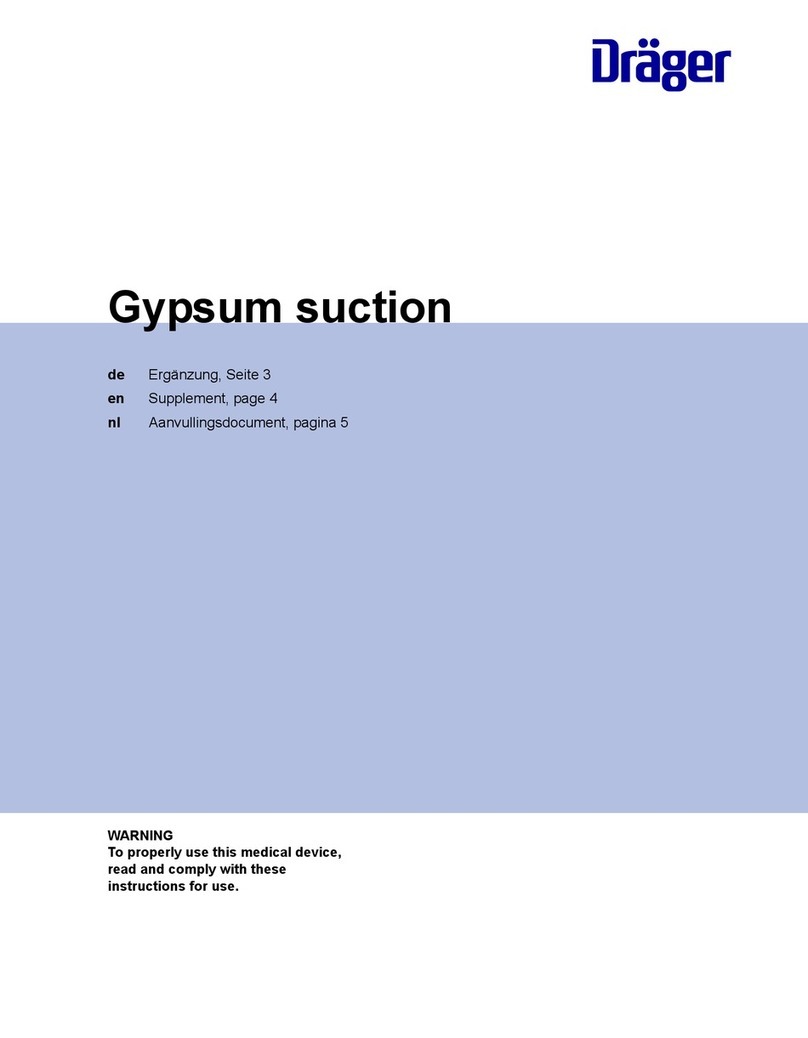
Dräger
Dräger Agila Supplement manual
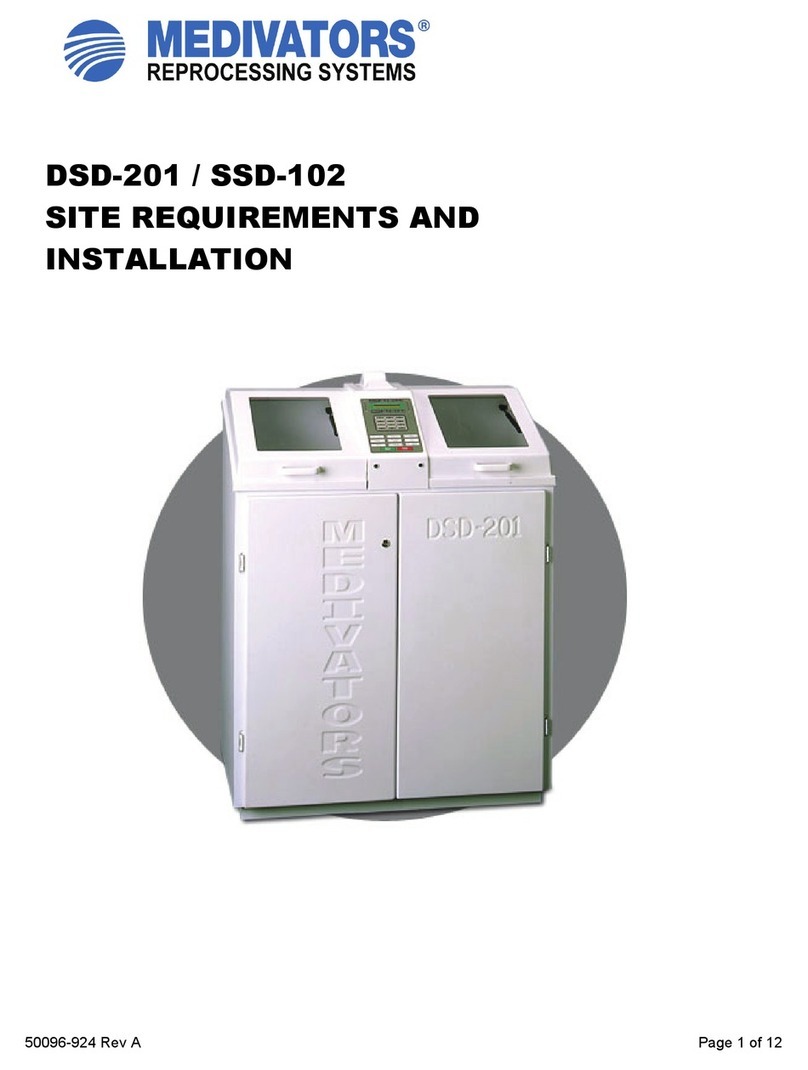
Medivators
Medivators DSD-201 Site requirements and installation

Cytori Therapeutics
Cytori Therapeutics celution GP Quick reference guide
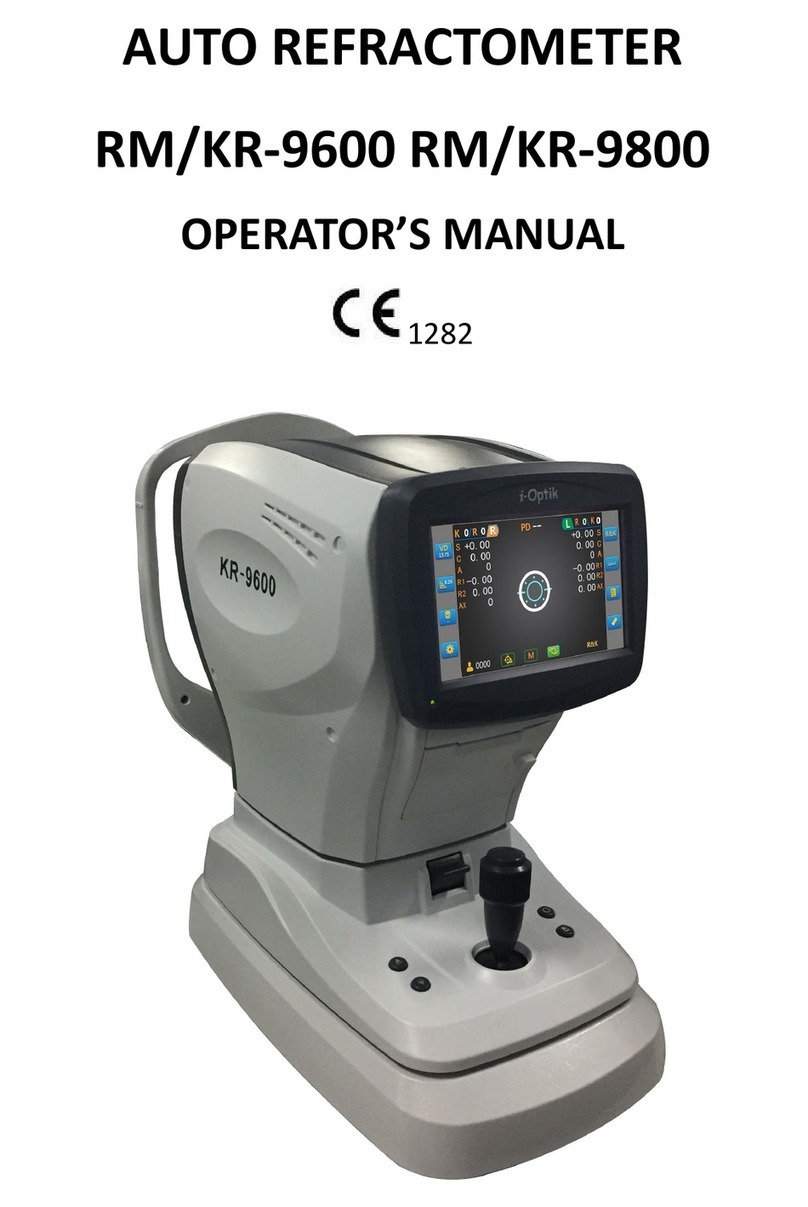
Crescent
Crescent RM-9600 Operator's manual

WillowWood
WillowWood ONE User instructions

Heka Dental
Heka Dental UnicLine 5D Mounting instructions
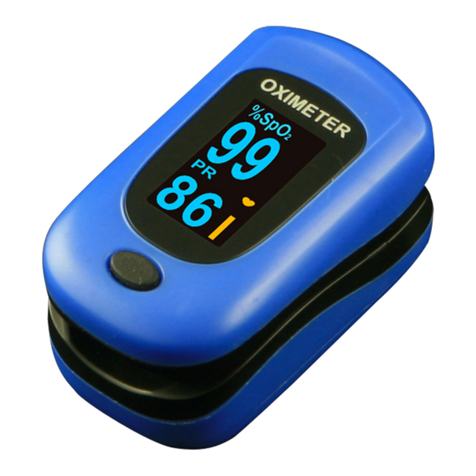
Creative Medical
Creative Medical PC-60B1 user manual
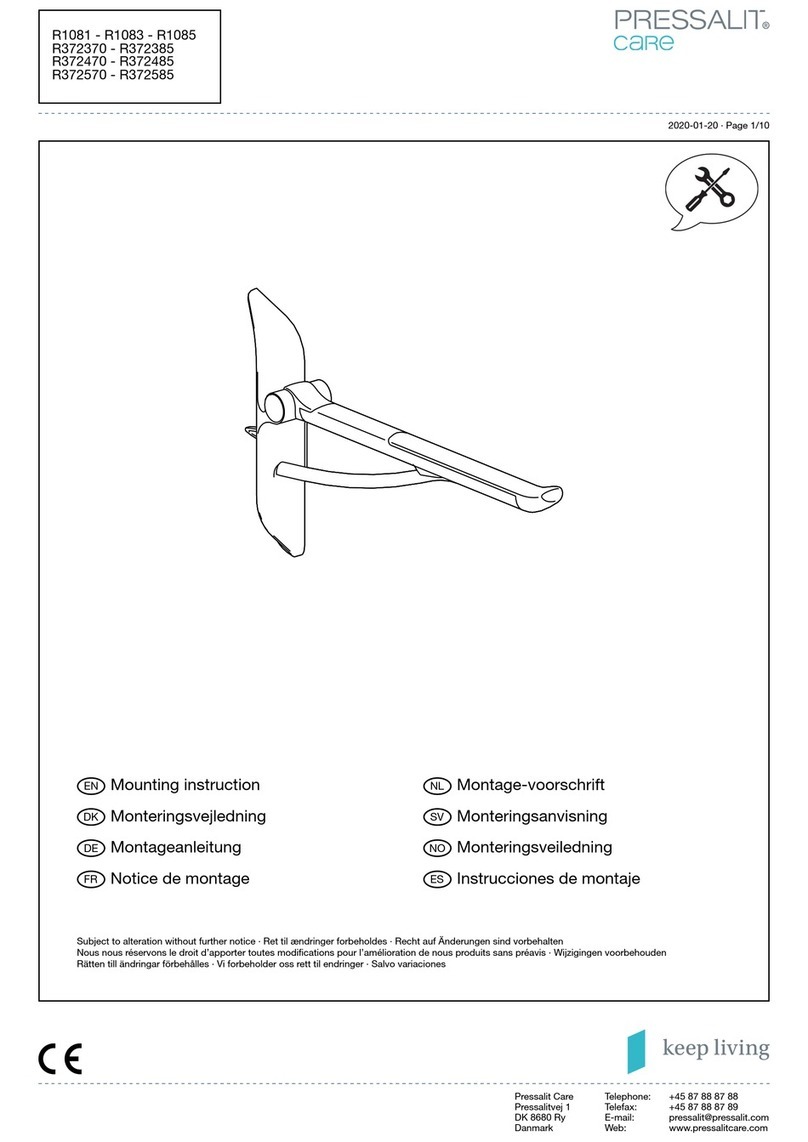
Pressalit Care
Pressalit Care R1081 Mounting instruction
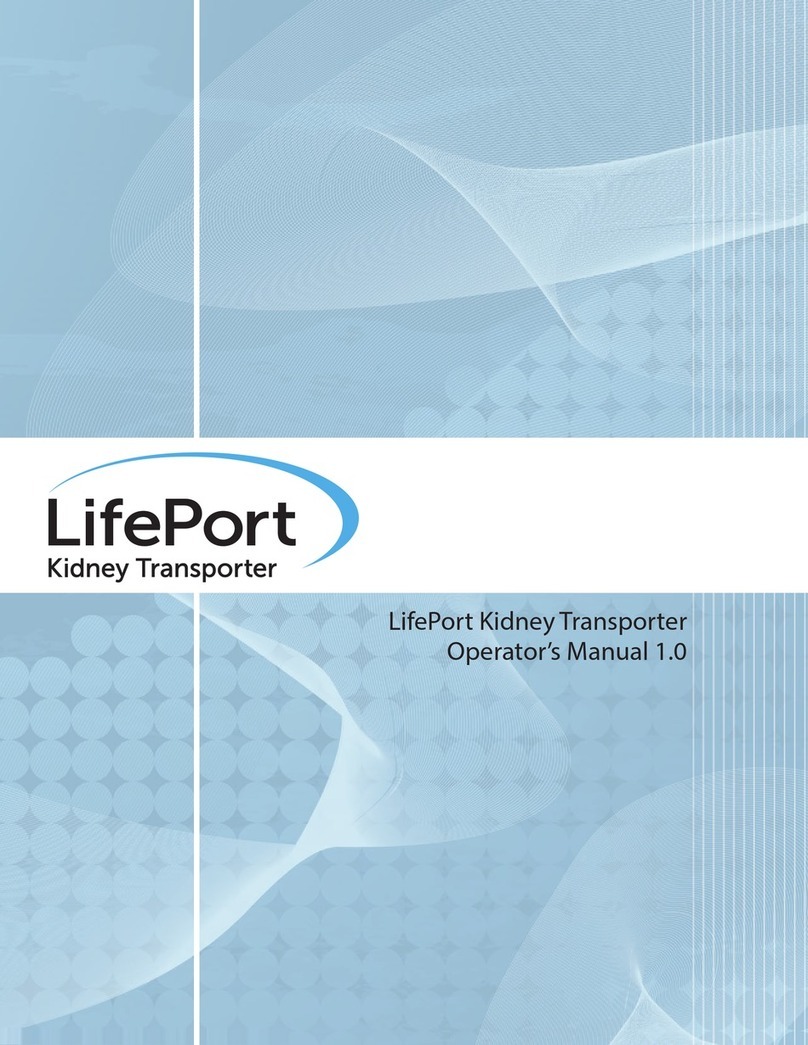
Organ recovery systems
Organ recovery systems LifePort Kidney Transporter LKT100P Operator's manual
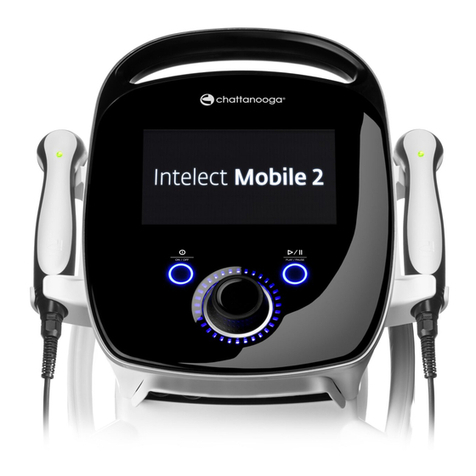
Chattanooga
Chattanooga Intelect Mobile 2 Ultrasound quick start guide
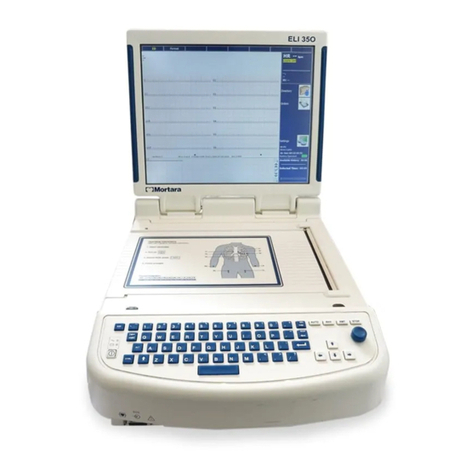
Mortara
Mortara ELI 350 user manual
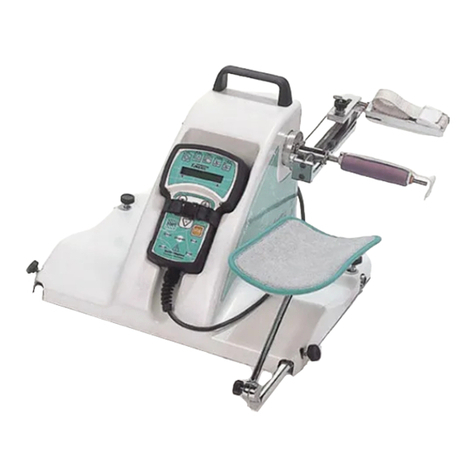
Kinetec
Kinetec Maestra manual
